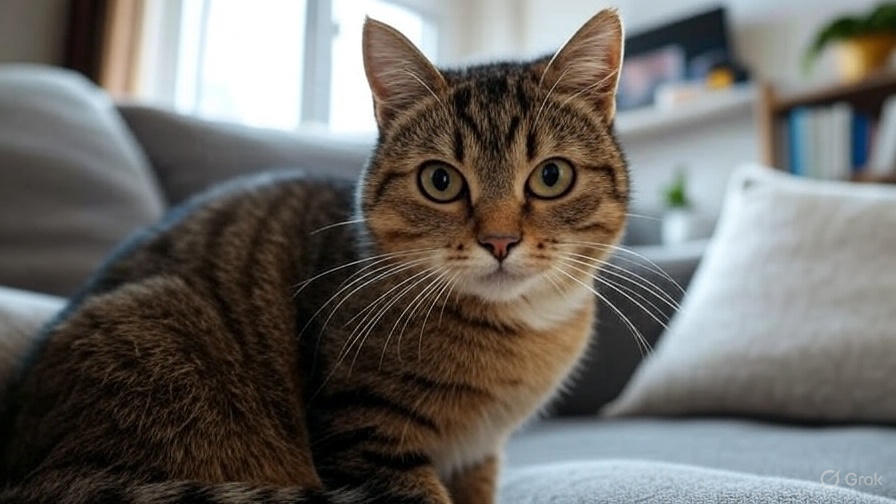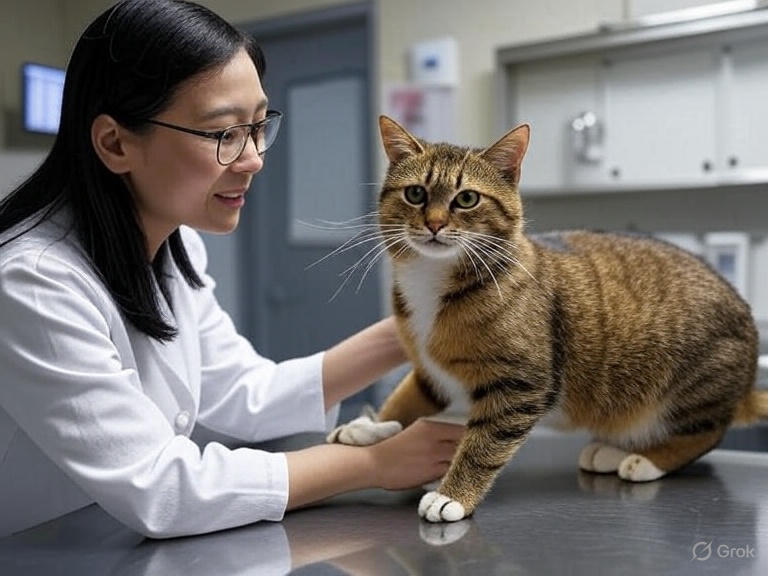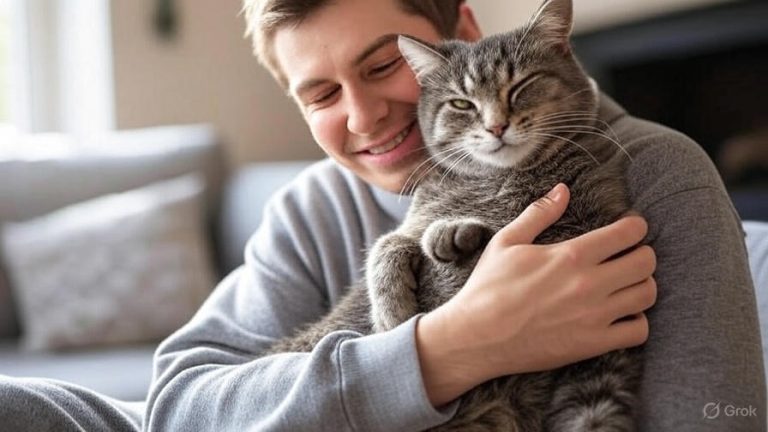How to Keep Your Cat From Spraying?
Cat spraying can turn your peaceful home into a frustrating battleground. Your beloved feline companion suddenly starts marking walls, furniture, and other surfaces with strong-smelling urine, leaving you wondering what went wrong. The good news is that cat spraying behavior can be managed and often eliminated with the right approach.
This comprehensive guide will walk you through proven strategies to stop your cat from spraying and restore harmony to your household. You’ll discover the root causes behind this behavior and learn practical solutions that work.
Why Cats Spray: The Science Behind Territorial Marking
Cats spray for completely different reasons than regular urination. When your cat eliminates in the litter box, they squat down and release urine downward. Spraying involves your cat backing up to a vertical surface, lifting their tail high, and releasing small amounts of urine backward onto walls, furniture, or other upright objects.
This behavior serves as a communication system in the feline world. Wild cats use urine marking to establish territory boundaries, advertise their presence to potential mates, and signal their reproductive status to other cats. Your house cat retains these same instincts, even though they live in a domestic environment.
The spray itself contains more concentrated pheromones than regular urine. These chemical messages carry detailed information about your cat’s identity, health status, and emotional state. Other cats can read these signals like a complex social media post.
Male cats spray more frequently than females, especially unneutered males. However, both sexes can develop spraying habits under certain circumstances. Spayed and neutered cats spray less often but may still exhibit this behavior when stressed or threatened.
Medical Causes: When Health Issues Trigger Spraying
Before addressing behavioral causes, rule out medical problems that might cause inappropriate urination. Several health conditions can make cats associate their litter box with pain or discomfort, leading them to seek alternative elimination spots.
Urinary tract infections cause burning sensations during urination. Your cat might avoid the litter box because they associate it with pain. They may spray small amounts frequently as their inflamed bladder struggles to hold normal volumes of urine.
Bladder stones create sharp pain and can block normal urine flow. Cats with stones often strain to urinate and may only produce small amounts at a time. This mimics spraying behavior and can confuse pet parents.
Kidney disease affects your cat’s ability to concentrate urine properly. They produce larger volumes of dilute urine and need to eliminate more frequently. Some cats develop litter box aversions when they can’t make it to the box in time.
Arthritis makes climbing into high-sided litter boxes painful for senior cats. They might spray nearby walls instead of struggling to enter their box. Joint pain also makes the squatting position uncomfortable, leading some cats to prefer the standing spray position.
Diabetes causes excessive thirst and urination. Your cat’s litter box fills up faster, and they may avoid using a soiled box. The increased urgency can lead to accidents that look like marking behavior.
Schedule a veterinary examination if your cat suddenly starts spraying. Blood tests, urine analysis, and physical exams can identify medical causes that require treatment. Resolving health issues often eliminates spraying behavior entirely.
Stress and Anxiety: Environmental Triggers That Cause Spraying
Cats are creatures of habit who thrive on predictability. Changes in their environment can trigger stress responses, including territorial marking. Even positive changes like new furniture or renovations can upset sensitive cats enough to start spraying.
Moving to a new home tops the list of stress triggers. Your cat loses all their familiar scent markers and feels compelled to establish new territory boundaries. The unfamiliar smells and layout create anxiety that manifests as spraying behavior.
New pets in the household threaten your cat’s established social hierarchy. They may spray to reinforce their territorial claims and communicate their presence to the newcomer. This behavior often intensifies during the initial introduction period.
Changes in family dynamics also affect cats deeply. New babies, roommates, or romantic partners alter household routines and attention patterns. Your cat might spray to cope with feeling displaced or to mark areas where they feel secure.
Construction noise, parties, or other disruptions create temporary stress spikes. Some cats handle these events well, while others develop lasting anxiety that continues long after the disturbance ends.
Even subtle changes like switching litter brands or moving the food bowl can trigger spraying in highly sensitive cats. Their acute sense of smell detects alterations that humans barely notice.
Multi-Cat Households: Managing Territory Disputes
Homes with multiple cats face unique challenges when it comes to spraying behavior. Cats establish complex social hierarchies and territorial boundaries that invisible to human eyes. Competition for resources, space, and attention can escalate into marking wars.
Resource guarding drives much of the conflict in multi-cat homes. Cats may spray near food bowls, water dishes, or favorite sleeping spots to claim ownership. This behavior intensifies when resources are limited or poorly distributed throughout the home.
Litter box politics create another source of tension. Some cats refuse to share boxes with others, while dominant cats might guard the litter area and prevent subordinate cats from using it. This forces some cats to find alternative elimination sites.
Social incompatibility between cats can persist for years without resolution. Cats who never fully accept each other may engage in ongoing territorial disputes that include spraying, blocking, and other passive-aggressive behaviors.
The solution involves creating separate resources for each cat. Provide multiple food stations, water bowls, and sleeping areas throughout your home. Follow the “one plus one” rule for litter boxes – offer one box per cat plus one extra.
Place resources in different areas so cats can avoid each other when needed. Vertical space becomes crucial in multi-cat homes. Install cat trees, shelves, and perches to create separate territories at different levels.
Neutering and Spaying: The Most Effective Prevention Method
Surgical sterilization remains the single most effective way to prevent cat spraying. Intact male cats have overwhelming hormonal drives to mark territory and attract mates. These instincts are so strong that even indoor cats with no access to females will spray extensively.
Testosterone fuels the majority of male marking behavior. Neutering eliminates this hormone source and dramatically reduces spraying urges. Most male cats stop spraying within weeks of their surgery, though some may take several months to completely abandon the habit.
Female cats spray less frequently than males, but intact females still mark during heat cycles. They use urine marking to advertise their reproductive availability and attract potential mates. Spaying eliminates these hormonal fluctuations and reduces marking behavior.
Early sterilization provides the best results. Cats neutered before reaching sexual maturity rarely develop spraying habits. The ideal age for surgery is between 4-6 months, before hormonal influences become established.
Even cats who have already started spraying benefit from sterilization. About 90% of male cats stop spraying after neutering, though the behavior may take time to fade completely. Some cats continue spraying due to learned habits or ongoing stress factors.

Environmental Management: Creating a Spray-Free Home
Your home environment plays a crucial role in preventing and stopping spraying behavior. Cats feel most secure in predictable, resource-rich environments where they don’t need to compete or feel threatened.
Litter box management forms the foundation of good elimination habits. Keep boxes scrupulously clean by scooping daily and completely changing litter weekly. Cats have sensitive noses and may avoid boxes that smell offensive to them.
Box placement affects usage patterns significantly. Avoid placing boxes in high-traffic areas, near noisy appliances, or in dark basements. Cats prefer quiet, accessible locations where they won’t be startled or trapped while vulnerable.
The type of litter matters more than many pet parents realize. Most cats prefer unscented, clumping clay litters with a fine texture. Avoid strongly perfumed or crystal litters that might irritate sensitive paws or noses.
Create multiple territory zones throughout your home. Set up feeding stations, sleeping areas, and play zones in different rooms so cats can establish separate territories without conflict. This reduces competition and territorial anxiety.
Cleaning and Odor Elimination: Breaking the Spray Cycle
Thorough cleanup of spray sites is essential for preventing repeat incidents. Cat urine contains persistent compounds that continue attracting your cat back to the same spots. Regular household cleaners can’t eliminate these odors completely.
Enzymatic cleaners specifically designed for pet urine break down the proteins and bacteria that create lasting smells. These specialized products actually digest the odor-causing compounds instead of just masking them with fragrances.
Avoid ammonia-based cleaners, which smell similar to cat urine and may actually encourage more spraying. Bleach can also react with urine compounds to create toxic chlorine gas, making it dangerous to use in enclosed spaces.
Black lights reveal dried urine spots that aren’t visible to the naked eye. These UV lights make urine deposits glow, helping you locate all the areas that need treatment. Many pet parents discover far more spray sites than they initially realized.
Steam cleaning carpets and upholstery helps penetrate deep into fibers where odor compounds hide. However, heat can actually set protein-based stains permanently, so test cleaning products in inconspicuous areas first.
Behavioral Modification: Training Your Cat Not to Spray
Training techniques can help modify spraying behavior, especially when combined with environmental management. Positive reinforcement works better than punishment for changing feline behavior patterns.
Interrupt spraying attempts with gentle redirection rather than loud corrections. Clap your hands or shake a can of coins to startle your cat away from spray sites, then immediately guide them to their litter box.
Reward appropriate litter box usage with treats, praise, or play sessions. Create positive associations with proper elimination behavior by making litter box visits rewarding experiences.
Motion-activated deterrents can protect previously sprayed areas while you work on behavior modification. These devices spray air or water when cats approach, teaching them to avoid problem spots without your direct intervention.
Make previously sprayed surfaces less appealing by changing their texture or purpose. Cover spray sites with aluminum foil, double-sided tape, or plastic sheeting temporarily while implementing other management strategies.
Synthetic Pheromones: Chemical Solutions That Really Work
Synthetic pheromone products mimic the natural calming chemicals that cats produce. These artificial versions can reduce stress and anxiety that contribute to spraying behavior.
Feliway diffusers release synthetic facial pheromones that signal safety and security to cats. Plug these devices into wall outlets near areas where spraying occurs. The pheromones create invisible comfort zones that help anxious cats relax.
Pheromone sprays allow targeted application to specific areas. Spray these products on previously marked surfaces after thorough cleaning. The synthetic pheromones overlay territorial markers with calming signals.
Calming collars provide portable pheromone therapy for cats who spray due to general anxiety. These collars release pheromones continuously, creating a personal comfort zone that travels with your cat.
Results from pheromone therapy vary between individual cats. Some respond dramatically within days, while others show gradual improvement over several weeks. Combine pheromone products with other management strategies for best results.
Anti-Anxiety Medications: When Natural Methods Aren’t Enough
Severe spraying problems sometimes require pharmaceutical intervention. Anti-anxiety medications can provide the chemical support needed to break persistent spraying habits.
Selective serotonin reuptake inhibitors (SSRIs) like fluoxetine help cats with chronic anxiety disorders. These medications balance brain chemistry to reduce the emotional triggers that cause spraying behavior.
Tricyclic antidepressants offer another medication option for cats with severe behavioral problems. These drugs affect multiple neurotransmitter systems and can be especially helpful for cats with obsessive-compulsive tendencies.
Gabapentin provides short-term anxiety relief for specific situations like vet visits or travel. This medication can help break spraying cycles triggered by temporary stressors.
All behavioral medications require veterinary supervision and monitoring. Your vet will determine appropriate dosages and watch for side effects during treatment. Most cats need several weeks to show full medication benefits.
Long-Term Success: Maintaining a Spray-Free Environment
Preventing future spraying episodes requires ongoing attention to your cat’s needs and environment. Successful management becomes a lifestyle rather than a temporary fix.
Monitor your cat’s stress levels by watching for early warning signs like hiding, appetite changes, or litter box avoidance. Address problems quickly before they escalate into spraying behavior.
Maintain consistent routines that provide security and predictability. Feed meals at regular times, keep litter boxes clean, and avoid unnecessary changes to your cat’s environment.
Continue using management strategies even after spraying stops. Keep pheromone diffusers running, maintain multiple litter boxes, and ensure each cat has adequate resources and territory.
Regular veterinary checkups help identify health problems before they trigger spraying relapses. Annual exams become even more important as cats age and develop chronic conditions.
Success Stories: Real Results From Dedicated Pet Parents
Many cat parents have successfully eliminated spraying problems using these comprehensive approaches. Sarah’s three-cat household stopped spraying after she installed multiple litter boxes and created separate feeding stations in different rooms.
Mike solved his male cat’s spraying problem by combining neutering with thorough odor elimination and Feliway diffusers. The behavior stopped completely within six weeks of starting the program.
Linda’s senior cat stopped spraying after veterinary examination revealed arthritis was making litter box access painful. Pain medication and low-sided boxes resolved the problem immediately.
These success stories share common elements: early veterinary consultation, thorough environmental management, and consistent application of multiple strategies. No single approach works for every cat, but comprehensive programs produce reliable results.
Taking Action: Your Next Steps to Stop Cat Spraying
Start by scheduling a veterinary examination to rule out medical causes for your cat’s spraying behavior. This crucial first step prevents weeks of frustration trying to solve a problem that requires medical treatment.
Implement environmental changes immediately while waiting for your vet appointment. Add extra litter boxes, separate feeding areas, and pheromone diffusers to begin addressing potential triggers.
Document your cat’s spraying patterns by noting when, where, and under what circumstances incidents occur. This information helps identify triggers and track improvement over time.
Be patient with the process, as behavioral changes take time to establish. Most cats show improvement within 2-4 weeks of starting comprehensive management programs, but some may need longer to completely abandon spraying habits.
Your cat’s spraying problem has solutions. With dedication, consistency, and the right approach, you can restore peace to your home and strengthen your relationship with your feline companion.







